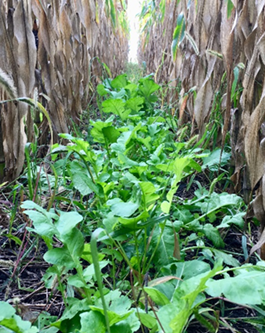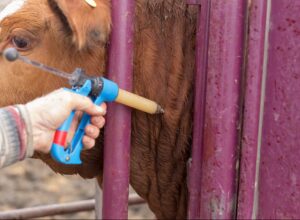Is This a Good Investment?
This article written by Dr. Reynold Bergen, BCRC Science Director, originally appeared in a September 2021 issue of Canadian Cattlemen magazine and is reprinted on the BCRC Blog with permission of the publisher.
The Beef Cattle Research Council (BCRC) projects featured in this column are funded by the Canadian Beef Cattle Check-Off. When the checkoff increased a few years ago, the BCRC’s budget rose from around 15 cents to 67 cents per head marketed. This allowed us to start some new research programs. Now that we’re a few years in I can update you on how they’re going.
One is our “Proof of Concept” program. Research is complicated and costly, so we have independent scientists review each research proposal to make sure it is scientifically sound and likely to achieve its goal before investing your dollars into it. Sometimes the reviewers say, “This is an interesting project, but it’s really costly, and it all hinges on an untested idea. It’d be better if they had some preliminary evidence that this new idea is worth pursuing, before funding a costly, full-scale project.”
In 2018 the BCRC started funding Proof of Concept projects to gather these preliminary results and help decide whether these new ideas are worth scaling up into full-scale research trials. Here’s what two of the first Proof of Concept projects told us.
Exploring corn intercropping strategies to increase protein and profitability of beef cattle grazing: Corn’s high yields and energy content make it a popular wintering grazing crop for some Western Canadian producers. However, its low protein content may make it unsuitable for younger, growing cattle. Seeding corn together with high protein forages may be a way around this challenge.
Drs. Emma McGeough and Yvonne Lawley ran a small plot study to compare the yields, nutritional value and economics of corn grown on its own or intercropped with high protein forages (either Italian ryegrass, hairy vetch, forage radish, or red clover or a mixture of all four species) at two sites in Manitoba in 2019. Forage was sampled and analyzed in October and December.
All treatments were established successfully at both locations despite drought challenges. The intercropping treatments increased production costs but did not significantly improve yields or energy and protein content compared to corn alone. Regardless of cropping strategy, feed analyses indicated that energy levels were adequate for cows and replacement heifers at the start of the second trimester but too low for growing steers. Crude protein levels were borderline for cows but still too low for both replacement heifers and growing steers.
Corn and high protein forage crops can be intercropped successfully, but more work is needed to make intercropping an economically reliable strategy to meet the nutritional needs of younger, growing cattle in winter. This team is refining intercrop seeding and fertilization recommendations for different locations across western Canada, as well as grazing trials to refine nutritional recommendations for wintering replacement heifers and growing steers on these mixtures.
Rapid disease diagnostics for Bovine Respiratory Disease (BRD): BRD remains one of the most common and costly feedlot diseases. Many different pathogenic bacteria can cause BRD, including Mannheimia, Pasteurella, Histophilus, Mycoplasma, and possibly others that haven’t been identified yet. Different bacteria respond to different antibiotics. In a perfect world, we’d have a point-of-care test that could instantly diagnose which bacteria are primarily responsible for each BRD case so that we could use the most appropriate antibiotic for each animal. Current tests to diagnose which specific bacteria are causing BRD in a particular animal can take up to a week. Even if the animal survived that long, the disease would have progressed. A completely different BRD bacteria (responding to a different antimicrobial) may have taken over, so we’d be back to square one. To avoid these unacceptable health, welfare and economic consequences, veterinarians and feedlot staff pull and treat cattle as soon as possible, using a broad-spectrum antibiotic that combats many different bacteria. Over time, this increases the risk of antibiotic resistance. We need to be able to treat BRD more strategically to maintain the effectiveness of these antibiotics.
Dr. Cheryl Waldner’s team conducted a proof-of-concept study to refine, simplify, speed up and automate an existing test for BRD pathogens. Samples were obtained veterinarians and from chronic feedlot cattle. The researchers evaluated a metagenomic sequencing methodology that identifies all the bacteria in the sample; most other approaches look for specific bacteria, running the risk of missing others. The results of the new test were compared to the gold standard lab culture.
The new test almost always detected the same (or more) bacteria than culture. They also detected antibiotic resistance genes, but more work is needed to identify which bacteria the genes came from. The new technique performed best in samples from very sick cattle that contain a lot of bacteria. More work is needed to make the tool effective for detecting BRD before symptoms appear.
Most of the steps involved in the new test could be reliably performed at a veterinary clinic with limited equipment. However, some steps (e.g., isolating DNA from the sample and separating calf DNA from bacterial DNA) are currently challenging to do outside the laboratory. The new test takes less than 6 hours. That is 97% faster than the week needed for traditional lab culture-based diagnostics, but still too slow to use in a commercial setting. This team is continuing to refine the test and improve its speed, informativeness and portability.
These two Proof of Concept projects showed enough promise to be pursued as larger research projects. Others showed less promise and allowed us to cut our losses. The BCRC started a few other programs when the National Check-Off increased, and I’ll explain those from time to time over the coming months.
The Beef Cattle Research Council is funded by the Canadian Beef Cattle Check-Off. The BCRC partners with Agriculture and Agri-Food Canada, provincial beef industry groups and governments to advance research and technology transfer supporting the Canadian beef industry’s vision to be recognized as a preferred supplier of healthy, high quality beef, cattle and genetics.
Click here to subscribe to the BCRC Blog and receive email notifications when new content is posted.
The sharing or reprinting of BCRC Blog articles is typically welcome and encouraged, however this article requires permission of the original publisher.
We welcome your questions, comments and suggestions. Contact us directly or generate public discussion by posting your thoughts below.

